| japanese | english |
yoshinobu nakagawa
july 6 - august 10, 2024 |
|
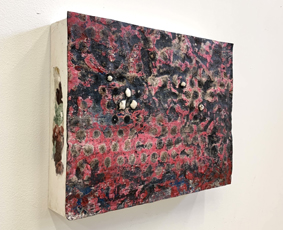
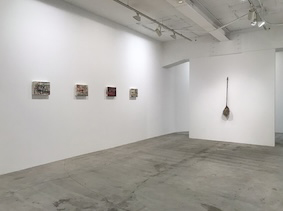
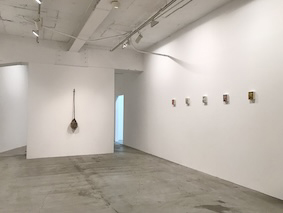
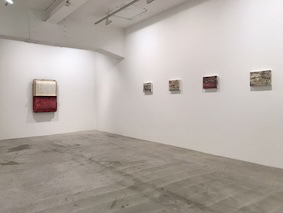
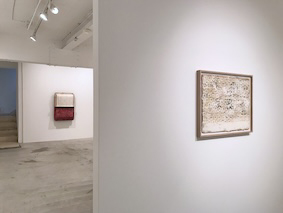
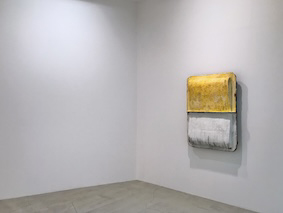
|
Born in Osaka in 1964, Yoshinobu Nakagawa now resides in Shiga prefecture. Ever since his first one-person show in 1987, the year he graduated from Osaka University of Art, Nakagawa's motif has been consistently relationship between plants (nature) and human being (farmer), namely, agriculture and cultivation, that is a fundamental activity to us. or structure of plants. For Nakagawa, relation between artist and art works resembles that between farmer and plants. He puts pigment on canvas as famers sow plant seeds on the earth. He works on materials as farmers cultivate the field. His artisanship, which freely controls every kind of materials and the poetic emotions sprung from the naive form of his work, has attracted many people. And his works are housed in many museum collections as the National Museum of Modern Art, Tokyo or Museum of Modern Art, Wakayama and in many company collections as Showa Shell Sekiyu K.K., Tokyo. Deciding on the title of this exhibition, Nakagawa chose again the words, "views of seeds, eyes of farmers", a concept that is the starting point and standard for his work for the first time in the past 30 years. The "views of seeds" refers to seeds that are weak but always ready to germinate when the opportunity comes, and which, in the course of evolution, have been able to fly far away on the wind by attaching fluff or wings, or by attaching themselves to human clothing or animal hair, or by being eaten by birds and other predators, thereby preserved their species. The "eyes of farmers" is the skill that has controlled these clever strategists. The eyes of farmers is also a sensor to judge the ever-changing seasons and weather, and has repeatedly crossbred and produced good breeds according to the convenience of human beings. I think it was during my second year in university that I began to work with the word gagricultureh in the back of my mind. At the end of the 80's, when I was wondering what makes me who I am and what is the core of my expression in the age of revival of the image and new-expressionism, I watched a documentary video on Jackson Pollock, which gave me the idea of connecting two worlds in different dimensions. My father's family had lived as a farmer (my father was the youngest child and was allowed to go to college and chose to become a teacher) in the Kawachi Plain in the southeastern part of Osaka, and I loved following my uncle around as a child. My uncle's family ran a farm near my home. When the cherry blossoms finished blooming, my uncle began plowing the fields and preparing for rice planting. The image of him making a rice plant nursery beside a rice field and sowing rice seeds overlapped with the image of Pollock's dripping technique, which I had seen in a documentary, in which he dripped paint onto a lying canvas. My uncle, who walks around the rice plant nursery sowing seeds, probably doesn't know about the painter Pollock. Pollock also did not know that Japanese farmers were doing something similar to what he was doing. Knowing both of them, I thought that by connecting them, I could realize "what makes me who I am" and express it. The word "agriculture" is made up of the word "agri", which means "farming", and the word "culture". And the word "culture" also includes the meaning of "cultivation". That is something stimulated my interest. Although the connection between agriculture and fine art may be unimportant to others, it is a fact that I have been creating my work while cultivating the materials. I have been expressing myself by scraping, washing, and polishing my own oil paintings that I painted during my practical training as a student, and used canvases that others had discarded until the images were gone, and then placing a minimal amount of paint on them. People often ask me, "why is it that some of your work is two-dimensional and some is three-dimensional ?" If I may say so, when I am concerned about an action such as "sowing a seed", it stands up as a three-dimensional object in the space. In contrast, when I think of the existence of "sown seeds", I can only say that they are the result of being "sown" in a field or in a rice plant nursery, and for me, all two-dimensional or flat art works are the result. The relief sculpture titled "Two Ridges", which consists of two ridges of the same form joined at the top and bottom, was derived from the act of plowing the ridges of a field, and the shape of the soil when the hoe is swung over the ridges and pulled forward. After filling the ditch in the middle with fertilizer and humus, it is refilled and neatly arranged, waiting for the next time to sow seeds. It was created to make eternal the momentary shape of the soil shown by the movement of the hoe in this labor, a shape that I had produced once before in 2008. The reason why I decided to create again relief works using the trajectory of labor as a motif was because I wanted to make the relationship between the upper and lower parts of the work clearer (in terms of color and texture) and present it in the space. Yoshinobu Nakagawa We are looking forward to your visit. checklist of the instllation 1. Two Ridges (White and Red), 2024 reclaimed paper, cotton, oil, acrylic, beeswax, cowhide and string 107.0 x 75.0 x 21.0cm 2. Germination on the table 240005, 2024 oil on canvas, heat, plaster, cotton and beeswax 24.6 x 33.7 x 5.2 cm 3. Germination on the table 240009, 2024 oil on canvas, heat, plaster, cotton and beeswax 24.6 x 33.7 x 5.2 cm 4. Germination on the table 240003, 2024 oil on canvas, heat, plaster, cotton and beeswax 24.6 x 33.7 x 5.2 cm 5. Germination on the table 240004, 2024 oil on canvas, heat, plaster, cotton and beeswax 24.6 x 33.7 x 5.2 cm 6. Hanging #240001, 2024 acrylic, terra-cotta, silver foil, cotton, cowhide, string and bronze 120.0 x 21.0 x 15.0 cm 7. Layer 240011, 2024 oil, canvas, heat, plaster, cotton and beeswax 13.0 x 10.0 x 5.0 cm 8. Layer 240015, 2024 oil, canvas, heat, plaster, cotton and beeswax 13.0 x 10.0 x 5.0 cm 9. Layer 240012, 2024 oil, canvas, heat, plaster, cotton and beeswax 13.0 x 10.0 x 5.0 cm 10. Layer 240013, 2024 oil, canvas, heat, plaster, cotton and beeswax 13.0 x 10.0 x 5.0 cm 11. Layer 240014, 2024 oil, canvas, heat, plaster, cotton and beeswax 13.0 x 10.0 x 5.0 cm 12. Untitled (Painting), 2023 cotton, acrylic, oil and reclaimed paper 49.0 x 62.5 cm 13. Two Ridges (Yellow + White), 2023 reclaimed paper, cotton, oil, acrylic, beeswax, cowhide and string 107.0 x 75.0 x 21.0cm 14. Untitled (Surface)#2, 2021 acrylic, tracing paper, beeswas and panel 49.0 x 62.5 cm 15. Seed on the table 240001, 2024 oil on canvas, soot, tracing paper and beeswax 49.0 x 62.5 cm 16. Seed on the table 240002, 2024 oil on canvas, soot, tracing paper and beeswax 49.0 x 62.5 cm |